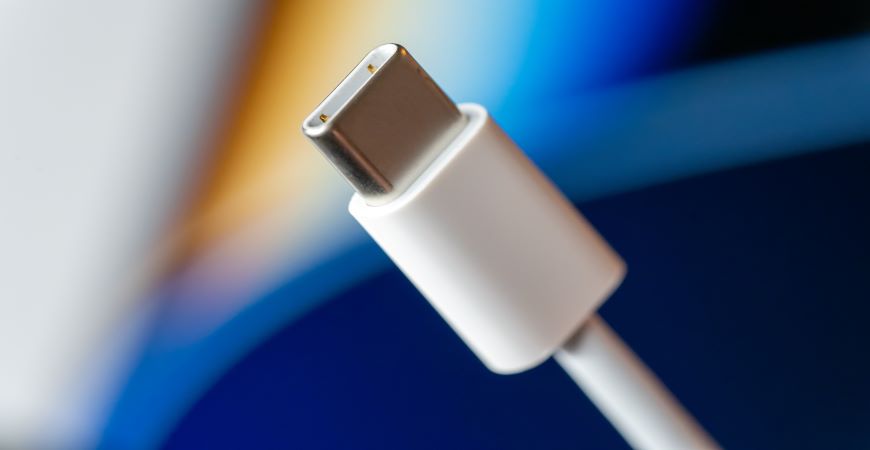Universal chargers: one size will finally fit all

Universal chargers for mobiles and small tech should save consumers money and time and help reduce e-waste. As the new Common Charger Directive gets final approval, Euroconsumers will make sure consumers aren’t short changed.
The long running campaign for a common standard for charging points for smartphones and similar devices had a major victory this week. A new EU Directive will make the USB-C charging port mandatory for a wide range of common, smaller electronic devices, regardless of manufacturer.
Mobile phones, tablets, e-readers, earbuds, digital cameras, headphones and headsets, handheld videogame consoles and portable speakers – indeed most things that recharge via a wired cable will need to adapt by 2024. Laptops also come under the rules, but they have longer to adapt given their range of power, size and wider variety of existing charging ports.
“People will now be able to charge a huge range of devices with the same charger – this simple fact will make life much more convenient and hopefully dramatically reduce the number of chargers and wires that make it into landfill each year”
Els Bruggeman, Head of Policy and Enforcement, Euroconsumers
Another strong driver for the changes is the environmental impact of so many incompatible chargers. The European Commission research estimated that unused or unwanted charging cables generated more than 11,000 tonnes of waste per year. Making a common charger mandatory will not only reduce the amount going to landfill but will cut down on the resources used in production and transportation.
Yet this raises other eco-questions – for example, given their ubiquity, should chargers have a minimum mandated lifespan or ambitious standards for energy use? Should manufacturers take back and replace defective or out of date chargers and play their part in the circular economy by re-manufacturing the materials?
Standardising information in universal chargers roll out
Also included in the final agreement are requirements for clear information and labelling of new devices. Under the new rules, products must have a visual to show whether a new device comes with a charger and the minimum and maximum power it can provide.
Consumer organisations can help here by working closely with standards bodies and stakeholders to ensure all the options are labelled carefully and clearly. They can also organise awareness campaigns and prepare the right advice to help consumers make the sustainable choice when buying a new device.
Unbundling universal chargers
The common situation where chargers are ‘bundled’ into new devices is likely to slowly decline. The Commission will decide whether unbundling will become a mandatory default following a review in four years’ time.
However, the assumption that excluding chargers will save people money may not be entirely accurate as there is no guarantee that manufacturers and retailers will reflect this product cost reduction in their pricing.
What’s more, Euroconsumers’ Belgian member Test Achats’ engineering experts point out a pattern that emerged when Apple and Samsung, the main smartphone manufacturers, stopped providing chargers as a default in 2020. Market data suggests that by 2021, sales of chargers in Belgium had doubled – showing there was still a huge demand for chargers, and that companies making compatible chargers (including Apple and Samsung) were able to take advantage of the changes to make extra from consumers.
“While unbundling of chargers from devices rolls out, Euroconsumers would like to see both options available to consumers, clearly differentiated by price to make sure these changes drive consumer choice and don’t leave them out of pocket.”
Els Bruggeman, Head of Policy and Enforcement, Euroconsumers
Universal chargers: close watch on transposition issues
A few items were left to be addressed later, once standards authorities and the Commission have done more work. These include wireless charging, which could eventually leave the familiar hard-wired charger standard redundant.
Wireless charging is relatively new and not yet harmonised across devices, so agreeing specifications for compatible and interoperable charging at this stage would be helpful for unlocking innovation and smoothing out the journey to wireless charging across more and more devices.
There are also plans to set a certain charge speed. Euroconsumers would also like to see standards applied to the type of cable, the maximum data throughput and the charging current – and that all this is properly communicated to consumers.
A universal welcome step in the right direction
As well as tackling a big consumer frustration, universal charger points can also have a positive impact on the environment and will contribute to reducing e-waste, and we welcome its place amongst the wider EU strategy for a circular economy.
Having that said, as always, the proof of the pudding will be in the eating, and clarity is still needed on certain areas, including what consumers can expect to be offered while the transition to universal chargers slowly takes hold.
The universal charger cannot be a freeway for manufacturers to increase consumer inconvenience while reducing costs (and raising profit). If the phone is offered without charger this should be reflected in the price – giving consumers a clear choice.
With proper choice, clear communication and a close eye on future developments around standards for cables, data throughput and charging current we can be hopeful of a more convenient and less wasteful charging future.

